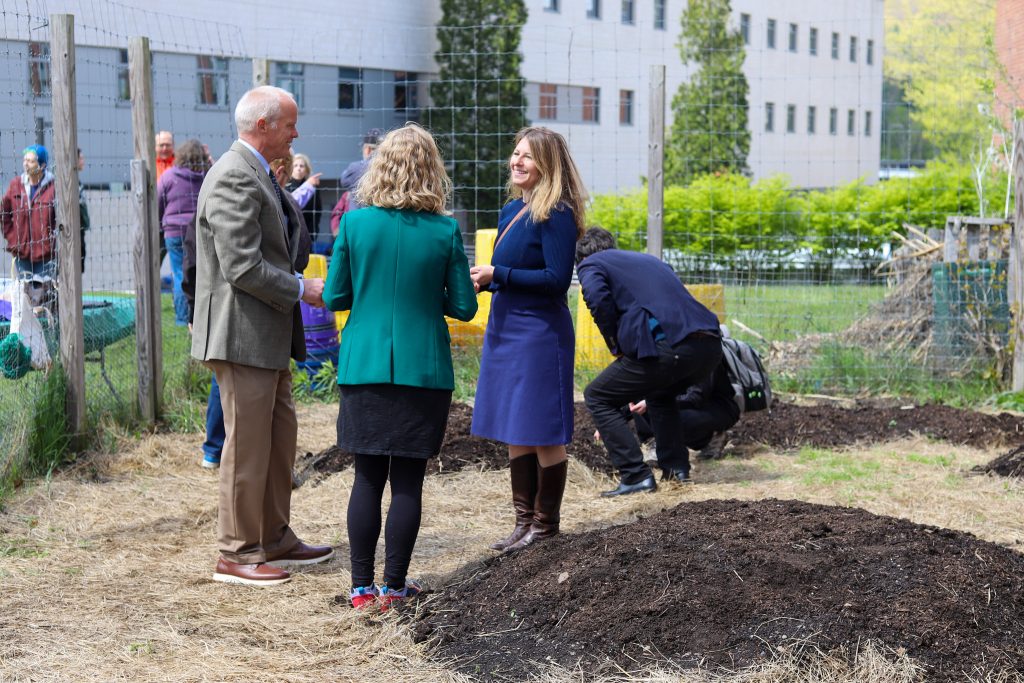Community members gathered on campus for the second annual planting of the Three Sisters Garden.
Located outside Science I, the Three Sisters Garden consists of three crops — corn, bean and squash — which were planted on six mounds of dirt. The garden was planted in the same traditional manner utilized by the people of the Haudenosaunee Nation, with the three sister crops supporting the growth of one another.
After being inspired by a similar garden located at Syracuse University, the Binghamton University garden was established in 2022 by two professors in the Center for Civic Engagement (CCE) and Angela Ferguson, the current director of the Onondaga Nation Farm and a member of the Eel Clan of the Haudenosaunee Confederacy, to maintain the relationship between the Haudenosaunee Nations and the land. The garden stands as a “Living Treaty,” according to the sign placed in front of it.
“Together we will travel in Friendship and in Peace Forever, as long as the grass is green, as long as the water runs downhill, as long as the sun rises in the East and sets in the West, and as long as our Mother Earth will last,” the sign reads.
One of the professors that helped to establish the garden at BU was Barrett Brenton, a faculty engagement associate for the CCE and professor of anthropology. According to Brenton, the group chose to create six mounds to represent the six Haudenosaunee Nations — the original five being the Mohawk, Oneida, Onondaga, Seneca and Cayuga and the sixth being the Tuscarora.
Brenton acknowledged the relationship between the Haudenosaunee and the land.
“Essentially, planting the seeds here is to establish that these Nations are still here,” Brenton said. “[The Nations are] still on the land upon where we are residing. They are not some past Native American group that has disappeared.”
The second professor that established the BU Three Sisters Garden was BrieAnna Langlie, an assistant professor of anthropology. Langlie explained that the garden also serves as a pedagogical tool, describing it as a “living classroom about indigenous knowledge.” Langlie said her course, Archaeology of Domestication, was one of the classes to visit this semester.
“It’s not just about the garden,” Langlie said. “It’s about interactions with Haudenosaunee people that live in this region. It’s about the plants themselves as well as a pedagogical tool, so it’s very multifaceted.”
During the academic months, classes ranging from environmental science to anthropology were involved with the garden. It was maintained by volunteers during the summer months.
Students expressed pride toward the Three Sisters Garden and its location on campus. Lee Hammond, a junior majoring in anthropology, explained why they attended the planting and the significance of events that maintain cultural relationships.
“I just find that knowing this culture and these people are alive and thriving today is really important,” Lee said. “The relationships and knowledge that we share is also very important.”
Alicia Baj, a sophomore majoring in integrative neuroscience, expressed enthusiasm about the garden’s mission and its inclusion of the student community.
“I am proud to be a student at a university that values the many groups and cultures within the community,” Baj said. “It’s cool that after all the hard work put in to upkeep the garden in the summer, there is a harvest in the fall. It seems like a very fun and rewarding project.”
Langlie encouraged students to participate in the garden’s upcoming events, including maintenance throughout the summer and the harvest in fall. She invited students staying in Binghamton through the summer to help weed and maintain the Three Sisters Garden every Friday at 10 a.m. The fall harvest will be held in conjunction with the Haudenosaunee festival on Sept. 30 on the Peace Quad.



